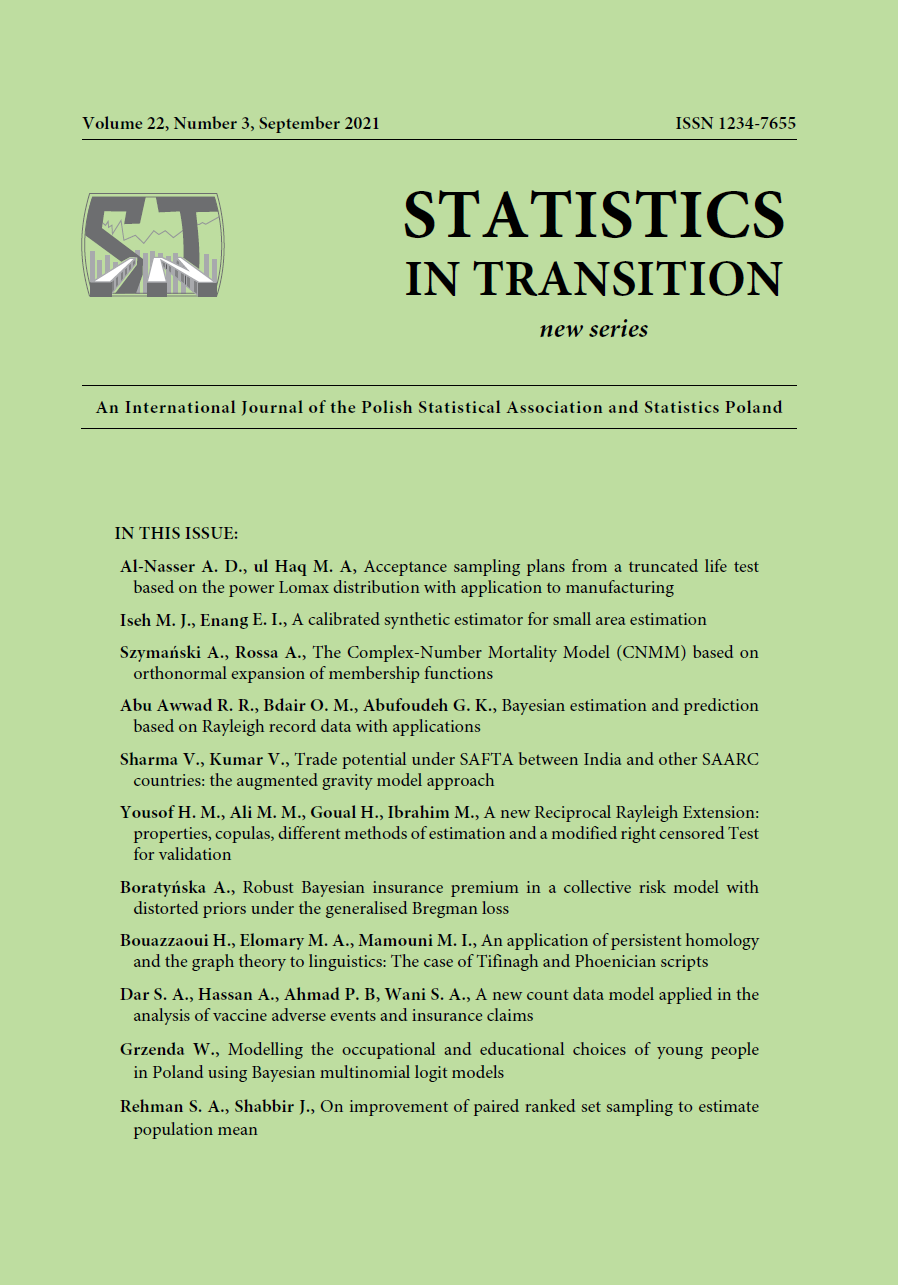ARTICLE
ABSTRACT
The study attempts to analyse India’s trade potential with other SAARC member states under the SAFTA agreement by means of the augmented gravity model, at annual frequency from 1992 to 2019 in general and from 2004 to 2019 in particular. The findings of this paper prove that the intra-regional trade volumes between SAARC countries can be increased and encouraged. Moreover, the research shows that it is important to introduce structural reforms aiming to boost trade with non-member states. It would be advisable for researchers to take into account the effect locational and infrastructural advantages have on transport costs through the application of a gravity model. Previous research has also demonstrated that the augmented gravity model may prove helpful in explaining some key features of South Asian trade, which traditional gravity models fail to do.
KEYWORDS
Cooperation/integration, augmented gravity model, panel data, trade potential, SAARC, SAPTA, SAFTA
REFERENCES
Balassa, Bela, (1962). The Theory of Economic Integration, George Allen & Unwin, London.
Bandara, J., W. Yu, (2001). How Desirable is the South Asian Free Trade Area? A Quantitive Assessment, Paper presented to the Fourth Annual Conference on Global Economic Ananlysis, Purdue University, Indiana, USA, June 27-29.
Batra, Amita, (2007). South Asia’s Free Trade Agreement: Strategies and Options, Economic & Political weekly, Vol.42, No.38, pp. 3878–3885.
Bhagwati, Jagdish, (1995). U.S. Trade Policy: The Infatuation with Free Trade Agreements, Discussion Paper Series No. 726.
Bhattacharyya, B., V. Katti, (2002). Regional Trade Enhancement: “SAPTA” and Beyond, http://www.iift.edu/publications/paper3.pdf.
Chowdhury, M. B., (2005). Trade Reforms and Economic Integration in South Asia. Applied Econometrics and International Development, Vol. 5(4), pp. 23–40.
Chowdhury, M., (1998). Resources Boom and Macroeconomic Adjustment: Theory and Evidence from Papua New Guinea, PhD Dissertation, Research School of Pacific and Asian Studies, Australian National University, Canberra, Australia.
Chowdhury, M., (2004). Resources Boom and Macroeconomic Adjustments in Developing Countries, Ashgate Publishing Limited, Gower House, England.
Department of Commerce under the Ministry of Finance, Government of India.
Din, M. U., Nasir S., (2004). Regional Economic Integration in South Asia: The Way Forward. The Pakistan Development Review, Vol. 43(4), pp. 959–974.
Ekanayake, E. M., Mukherjee, A. and Veeramacheneni B., (2010). Trade Blocks and Gravity Model: A Study of Economic Integration among Asian Developing Countries. Journal of Economic Integration, Vol. 25(4), pp. 627–643.
Hoekman, B., et al. (eds.), (2002). Development, Trade, and the WTO: A Handbook, The World Bank: Washington, D.C.
IMF, (2001). Balance of Payments Statistics Yearbook 2001, Vol. 2. IMF, Direction of Trade Statistics Yearbooks, various issues.
Kohli, E., (2004). Human Resource Development in SAARC Countries. Unpublished dissertation submitted to Guru Nanak Dev University, Amritsar for the degree of MSc in Economics at the Punjab School of Economics.
Pannu, N. K., (2005). Development Pattern of SAARC and Central Asian Countries. Unpublished dissertation submitted to Guru Nanak Dev University, Amritsar for the degree of MSc in Economics at the Punjab School of Economics.
Pitigala, N., (2005). What Does Regional Trade in South Asia Reveal about Future Trade Integration? Some Empirical Evidence, World Bank Policy Research Working Paper 3497, February 2005.
Rahman, M., Shadat, W. B. and Das, N. C., (2006). Trade Potential in “SAFTA”: An Application of Augmented Gravity Model. Occasional Paper, the Centre for Policy Dialogue, Dhaka, Bangladesh, Series 61.
S Perera, M. S., (2009). The South Asian Free Trade Area: an Analysis of Policy Options for Sri Lanka. Journal of Economic Integration, Vol. 24(3), pp. 530–562.
S Perera, M. S., (2009): “The South Asian Free Trade Area: an analysis of Policy Options for Sri Lanka”, Journal of Economic Integration, Vol. 24, No. 3, pp. 530–562. SAARC Website: data collected from http://saarcsec. org/areaofcooperation/detail.php?activity_id=5
SAARC’s Official website.
Sejuti, Jha, (2013). Utility of Regional Trade Agreements? Experience From India’s Trade Regionalism, Foreign Trade Review, Vol. 48, No. 2, pp. 233–245.
Sharma, N., Kumar, P., (2012). Growth and Pattern of India’s Intra-industry Trade with SAARC Nations. The Indian Economic Journal, Vol. 60(2), pp. 114–125.
Sharma, R., (2002). India’s Trade Relations with SAARC Countries in the context of Globalisation and Liberalisation. Unpublished PhD Thesis submitted at South Asian Studies Centre, University of Rajasthan, Jaipur.
Sharma, Vipin, (2019). India and Bangladesh Trade Potential under “SAFTA”, International Journal of Trade & Global Perspectives; Vol. 8(1), pp. 4109–4134.
Taneja, N., Prakash, S. and Kalita, P., (2013). India’s Role in Facilitating Trade under “SAFTA”. Indian Council for research on International Economic Relations (ICRIER), New Delhi, Working Paper, No. 26, pp. 31–19.
The Kathmandu Post, (2002). Nepal Gets up to 30 per cent Customs Tariff Concession, Kathmandu, November 27.
Udagedera, S., (2001). “SAPTA” Negotiations: Constraints and Challenges, in Impediments to Regional Economic Cooperation in South Asia, edited by Saman Kelegama, Institutie of Policy Studies of Sri Lanka and Coalition for Action on
South Asian Cooperation in association with Friederich-Ebert-Stiftung, Colombo Office.
Velde, D. W. T., (2011). Regional Integration, growth and Convergence, Journal of Economic Integration, Vol. 26(1), pp. 1–28.
Vipin and Vinod, (2016). Economic Integration among SAARC Countries: From “SAPTA” to “SAFTA”, Inter-State Conflicts and Contentious Issues in South Asia: Challenges and Prospects For SAARC, Kalpaz publications.
Vipin and Vinod, (2016). Trade Reforms and Economic Integration in SAARC Countries: “SAPTA” to “SAFTA”, International Journal of Entrepreneurship & Business Environment perspectives, Vol. 5, No. 4, pp. 2984–2996.
Weerakoon, Dushni, (2001): “Does “SAFTA” Have a Future”, Economic & Political Weekly, Vol. 36, No. 34, pp. 3214–3216.
Weerakoon, Dushni and Tayanthi Thennakoon, (2006). SAFTA” Myth of Free Trade”, Economic & Political Weekly, Vol. 41, No. 37, pp. 3920–3923.
Wooster, R. B., Banda, T. M. & Dube, S., (2008). The Contribution of Intra-regional and Extra-regional Trade to Growth: Evidence from the European Union. Journal of economic Integration, Vol. 23(1), pp. 161–182.
Zaheer, Dr. R., (2013). The Economic Performance of SAARC Member Countries. Research on Humanities and Social Sciences, Vol. 3(5), pp. 201–214.
